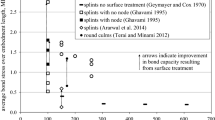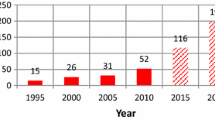Abstract
In this paper, the opportunities that can be provided by using geosynthetics are introduced. Many examples mentioned in the text show explicitly that geosynthetics can provide effective engineering solutions for a variety of projects ranging from extremely important to very simple projects. In order to illustrate the benefits of the geosynthetics, two applications were chosen as example applications. These were chosen from the applications where geosynthetic products are used most frequently, namely: reinforced walls and barrier systems. The most important research papers were referenced in these two subjects and examples from projects in Turkey were given. New geosynthetic products are brought to the market every day. To highlight this aspect, a relatively new, however, well-established technique was chosen: geosynthetic encased columns. Basic concepts of this technology is given. Many similar developments in the geosynthetic industry necessitates that engineers are up to date with the new developments in this field. It is well known that besides providing very efficient engineering solutions, use of geosynthetics also allows to reduce the construction time and cost. Recently, survivability issues are becoming as important as the other concerns. Therefore, at the very end of the paper examples are given of how the use of geosynthetics can reduce the carbon dioxide footprint.


















(courtesy GEOMAS)









(Courtesy: Huesker)



Similar content being viewed by others
References
Adams M, Nicks J, Stabile T, Wu T, Schlatter W, Hartmann J, (2011) Geosynthetic reinforced soil integrated bridge system, interim implementation guide. FHWA-HRT-11-026, p 159
Alexiew D, Brokemper D, Lothspeich S (2005) Geotextile encased columns (GEC): load capacity, geotextile selection and pre-design graphs. In: Proc. Geofrontiers 2005, Austin
Alexiew D, Raithel M, Kuster V, Detert O (2012) 15 years of experience with geotextile encased granular columns as foundation system. In: Proc. Int. Symp. on Ground Impr. IS-GI, ISSMGE TC 211, Brussels
Anon (2011) “EBGEO: recommendations for design and analysis of earth structures using geosynthetic reinforcements” German Geotechnical Society (DGGT). Ernst & Sohn, Essen-Berlin
Asif M, Muneer T, Kelly R (2007) Life cycle assessment: a case study of a dwelling home in Scotland. Build Environ 42:1391–1394
Athanassopoulos C, Vamos RJ (2011) Carbon footprint comparison of GCLs and compacted clay liners. In: The 24th annual GRI conference, Dallas, March 16, 2011, pp 142–157
Barksdale RD, Bachus RC (1983) Design and construction of stone columns. Federal Highway Administration. FHWA-RD-83-026
Barroso M, Touze-Foltz N, von Maubeuge K, Pierson P (2006) Laboratory investigation of flow rate through composite liners consisting of a geomembrane, a GCL and a soil liner. Geotext Geomembr 24:139–155
Basbug E (2012) Dynamic behavior of geogrid reinforced segmental block walls under earthquake loads. Ph.D. Thesis, Bogazici University
Belton, J et al (2008) Using geosynthetics to meet the challenge of improving material resource efficiency. In: Proc. EuroGeo4, Scotland, Paper #128
Bathurst RJ, Hatami K (1998) Seismic response analysis of a geosynthetic-reinforced soil wall. Geosynth Int 5(1–2):127–166
Bathurst RJ, Hatami K, Alfaro MC (2002) Geosynthetic-reinforced soil walls and slopes–seismic aspects. In: Shukla SK (ed) Geosynthetics and their applications. Thomas Telford, pp 327–392
Berg RR, Christopher BR, Samtani NC (2009) Design of mechanically stabilized earth walls and reinforced soil slopes. FHWA NHI-09-083, p 684
Bogazici University. Kandilli Observatory and Earthquake Research Institute. http://www.koeri.boun.edu.tr/depmuh_index_eng.aspx
Bonaparte R, Daniel DE, Koerner RM (2002) Assessment and recommendations for optimal perf. of waste containment systems. EPA/600/R- 02/099
Bouazza A (2002) Geosynthetic clay liners. Geotext Geomembr 20:3–17
Caterpillar Performance Handbook (2010) Edition 40
Chen Y, Lin W, Zhan TLT (2010) Investigation of mechanisms of bentonite extrusion from GCL and related effects on the shear strength of GCL/GM interfaces. Geotext Geomembr 28:63–71
Chulski KD (2015) A thesis entitled: life cycle assessment and costing of geosynthetics versus earthen materials. University of Toledo
DAI Environmental, Inc. (2010) AMCOL Greenhouse Gas Emissions, Int. Report
Daniel DE, Koerner RM (2007) Waste containment facilities: guidance for construction quality assurance and quality control of liner and cover systems
Daniel DE (2000) Hydraulic durability of geosynthetic clay liners. In: Proceedings of the 14th GRI conference (hot topics in geosynthetics), Las Vegas, pp 118–135
Di Prisco C, Galli A, Cantarelli E, Bongiorno D (2006) Geo-reinforced sand columns: small scale experimental tests and theoretical modeling. In: Proceedings of the 8th international conference on geosynthetics, Yokohama, pp 1685–1688
El-Emam M, Bathurst RJ (2004) Experimental design, instrumentation and interpretation of reinforced soil wall response using a shaking table. Int J Phys Model Geotech 4(4):13–32
El-Emam M, Bathurst RJ, Hatami K (2004) Numerical modeling of reinforced soil retaining walls subjected to base acceleration. In: 13th World conference on earthquake engineering, Vancouver, p 15
Erten D, Guler E (2016) Carbon footprint comparison of geogrid reinforced and reinforced concrete retaining walls in Turkey. In: 6th European geosynthetics congress, Ljubljana, pp 1414–1428
FHWA (2009) Design and Construction of Mechanically Stabilized Earth Walls and Reinforced Soil Slopes, Publication No. FHWA-NHI-10-024 Federal Highway Administration, FHWA GEC 011
Ghionna V, Jamiolkowski M (1981) “Colonne di ghiaia” X. Ciclo Di Conferenze Dedicate Ai Problemi Di Meccanica Dei Terreni E Ingegneria Delle Fondazioni Metodi Di Miglioramento Dei Terreni. Politecnico Di Torino Ingegneria, Atti Dell’istituto Di Scienza Delle Costruzioni, no 507
Guler E, Alexiew D, Basbug E (2012) Dynamic behavior of geogrid reinforced segmental block walls under earthquake loads. In: 3rd international conference on new developments in soil mechanics and geotechnical engineering, 28–30 June 2012, Near East University, Nicosia, North Cyprus
Guler E, Togrol E, Merdin E (1985) “Zemin Mekaniği Uygulamalarında Geotekstillerin Kullanılması”, İnşaat Mühendisleri Odası, Türkiye İnşaat Mühendisliği 8. Teknik Kongresi, Ankara, pp 173–187
Guler E, Hamderi M, Demirkan MM (2007) Numerical analysis of reinforced soil-retaining wall structure with cohesive and granular backfills. Geosynth Int 14(6):330–345
Guler E, Enünlü AK (2009) Investigation of dynamic behavior of geosynthetic reinforced soil retaining structures under earthquake loads. Bull Earthq Eng 7:737–777
Guler E, Çiçek E, Demirkan MM, Hamderi M (2012) Numerical analysis of reinforced soil walls with granular and cohesive backfills under cyclic loads. Bull Earthq Eng 10(3):793–811
Guler E, Selek O (2014) Reduced-scale shaking table tests on geosynthetic reinforced soil walls with modular facing. J Geotech Geoenviron Eng 140(6)
Guler E, Alexiew D, Abbaspour A, Koç M (2014) Seismic performance of geosynthetic encased stone columns. In: TRB 93rd annual meeting, Paper No. 14-1446, p 15
Hatami K, Bathurst RJ (2005) Development and verification of a numerical model for the analysis of geosynthetic-reinforced soil segmental walls under working stress conditions. Can Geotech J 42:1066–1085
Kaliakin V, Khabbazian M, Meehan C (2012) Modeling the behavior of geosynthetic encased columns: influence of granular soil constitutive model. Int J Geomech 12(4):357–369
Khabbazian M, Kaliakin VN, Meehan CL (2009) 3D numerical analyses of geosynthetic encased stone columns. In: Proc. of selected papers of the 2009 int. foundation cong. and equipment expo, pp 201–208
Koerner R (2009) Geosynthetics: a key toward sustainability, geosynthetics
Koseki J, Tatsuoka F, Watanabe K, Tateyama M, Kojima K, Munaf Y (2003) Model tests of seismic stability of several types of soil retaining walls. In: Ling H, Leshchinsky D, Tatsuoka F (eds) Reinforced soil engineering advances in research and practice. Marcel Dekker, New York, pp 378–385
Robinson PNJ, Quirk CM (2008) The UK aggregate levy and its implications to geosynthetics. In: Proc. EuroGeo4, Scotland, Paper #80
Koerner RM (2000) Emerging and future developments of selected geosynthetic applications. J Geotechn Geoenviron Eng 126(4):293–306
Koseki J, Bathurst RJ, Guler E, Kuwano J, Maugeri M (2006) Seismic stability of reinforced soil walls. In: 8th international conference on geosynthetics, 18–22 September 2006, Yokohama
Lee KZZ, Chang NY, Ko HY (2010) Numerical simulation of geosynthetic-reinforced soil walls under seismic shaking. Geotext Geomembr 28:317–334
Ling HI, Liu H, Kaliakin VN, Leshchinsky D (2004) Analyzing dynamic behavior of geosynthetic-reinforced soil retaining walls. J Eng Mech 130(8):911–920
Ling HI, Liu H, Mohri Y (2005) Parametric studies on the behavior of reinforced soil retaining walls under earthquake loading. J Eng Mech 131(10):1056–1065
Ling HI, Mohri Y, Leshchinsky D, Burke C, Matsushima K, Liu H (2005) Large-scale shaking table tests on modular-block reinforced soil retaining walls. J Geotech Geoenviron Eng ASCE 131(4):465–476
Ling HI, Yang S, Leshchinsky D, Liu H, Burke C (2010) Finite-element simulations of full-scale modular-block reinforced soil retaining walls under earthquake loading. J Eng Mech ASCE 136(5):653–661
McKenna JM, Eyre WA, Wolstenholme DR (1975) Performance of an embankment supported by stone columns in soft ground. Geotechnique 25(1):51–59
Murata O, Tateyama M, Tatsuoka F (1994) Shaking table tests on a large geosynthetic-reinforced soil retaining walls. In: Seiken Symposium No. 11, pp 259–264
Özhan H, Guler E (2013) Use of perforated base pedestal to simulate the gravel subbase in evaluating the internal erosion of geosynthetic clay liners. ASTM Geotech Test J 36(3):418–428
Petrov RJ, Rowe RK, Quigley RM (1997) Selected factors influencing GCL hydraulic conductivity. ASCE J Geotech Geoenviron Eng 123(8):683–695
Raithel M (1999) „Zum Trag- und Verformungsverhalten von geokunststoffummantelten Sandsaulen“Schriftenreihe Geotechnik, Heft 6. Universitat Gesamthochschule Kassel, Kassel
Raithel M, Kempfert HG (1999) „Bemessung von Geokunststoffummantelten Sandsaulen“ Die Bautechnik (76), Heft 12, Germany
Raithel M, Kempfert HG (2000) Calculation models for dam foundations with geotextile coated sand columns. In: Proceedings of the int. conf. on geotechnical & geological eng, GeoEng 2000, Melbourne
Raithel M, Kempfert HG, Kirchner (2005) „Berechnungsverfahren und Bemessung von ummantelten Saulen—Entwicklung und aktueller Stand“ 9. Informations- und Vortragstagung der Fachsektion “Kunststoffe in der Geotechnik” KGEO
Richardson GN (1997) GCL internal shear strength requirements. Geosynth Fabr Rep 15(2):20–25
Rowe RK, Abdelatty K (2013) Leakage and contaminant transport through a single hole in the geomembrane component of a composite liner. ASCE J Geotech Geoenviron Eng 139:357–366
Scalia J, Benson CH (2011) Hydraulic conductivity of geosynthetic clay liners exhumed from landfill final covers with composite barriers. ASCE J Geotech Geoenviron Eng 137:1–13
Shackelford CD, Sevick GW, Eykholt GR (2010) Hydraulic conductivity of geosynthetic clay liners to tailings impoundment solutions. Geotext Geomembr 28:149–162
Tandel YK, Solanki CH, Desai AK (2012) Reinforced granular column for deep soil stabilization: a review. Int J Civil Struct Eng 2(3)
Tatsuoka F (2014) Design, construction and performance of GRS structures for railways in Japan. Invited Lecture, First National Conference on Geosynthetics, Honduras, 16–18 June
Trauger RJ (1994) The structure, properties, and analysis of bentonite in geosynthetic clay liners. In: Proc. of the 8th GRI conference: geosynthetic resins, formulations, and manufacturing, GRI, Drexel University, Philadelphia, pp 185–198
USEPA (2005) emission facts: average carbon dioxide emissions resulting from gasoline and diesel fuel. Office of Transportation and Air Quality, EPA-420-F-05-001
USEPA (2005) Emission facts: metrics for expressing greenhouse gas emissions: carbon equivalents and carbon dioxide equivalents. Office of Transportation and Air Quality, EPA-420-F-05-002
USEPA (2008) eGRID-the emissions and generation resource integrated database for 2007. USEPA Agency Office of Atmospheric Programs
USEPA (2008) Climate leaders guidance for direct emissions from mobile combustion sources. Office of Air and Radiation (6202J), EPA430-K-03-005
USEPA (2008) Climate leaders guidance for optional emissions from commuting, business travel, and product transport. Office of Air and Radiation (6202J), EPA-430-R-08-006
USEPA (2010) Mandatory reporting of greenhouse gas emissions. Code of Federal Regulations, Title 40, Part 98
[web]. http://www.sustain.ucla.edu/about-us/what-is-sustainability/
Yonezawa T, Yamazaki T, Tateyama M, Tatsuoka F (2014) Design and construction of geosynthetic-reinforced soil structures for Hokkaido high-speed train line. Transp Geotech 1:3–20
Yoo C (2010) Performance of geosynthetic-encased stone columns in embankment construction: numerical investigation. ASCE J Geotech Geoenviron Eng 136(8):1148–1160
Author information
Authors and Affiliations
Corresponding author
Additional information
This paper was selected from GeoMEast 2017—Sustainable Civil Infrastructures: Innovative Infrastructure Geotechnology.
Rights and permissions
About this article
Cite this article
Guler, E. A material which started a new era in geotechnical engineering: geosynthetics. Innov. Infrastruct. Solut. 2, 36 (2017). https://doi.org/10.1007/s41062-017-0090-7
Received:
Accepted:
Published:
DOI: https://doi.org/10.1007/s41062-017-0090-7




